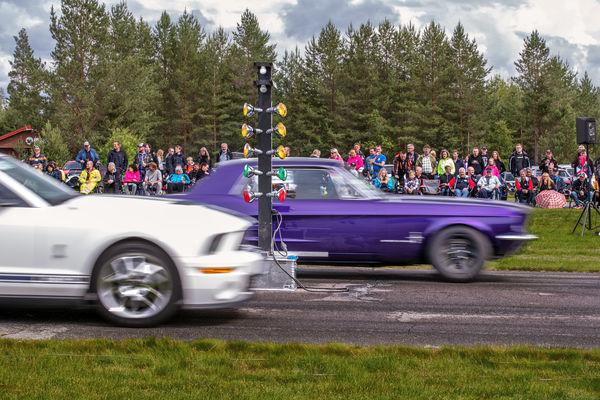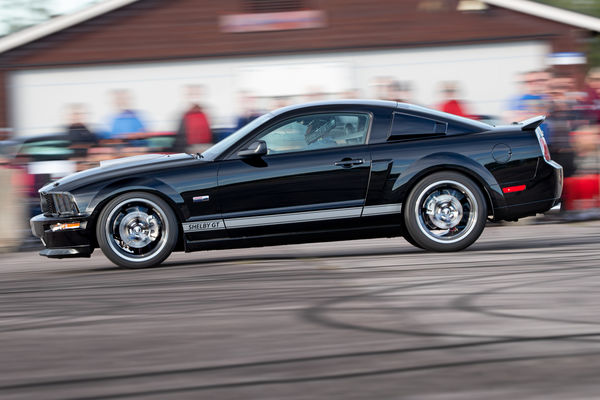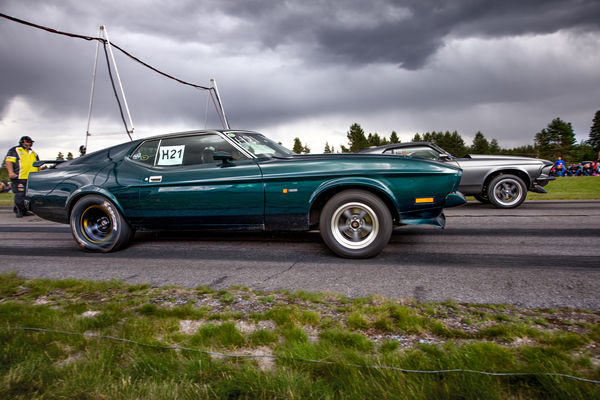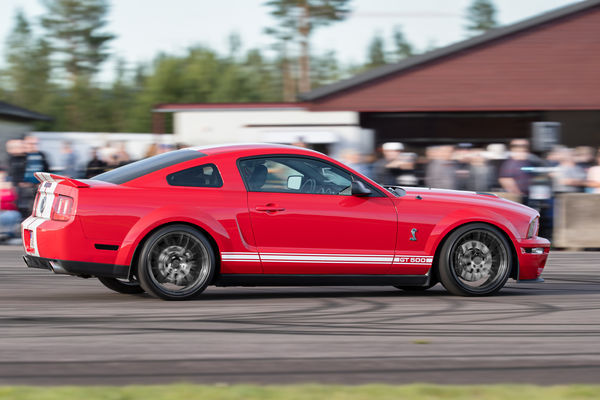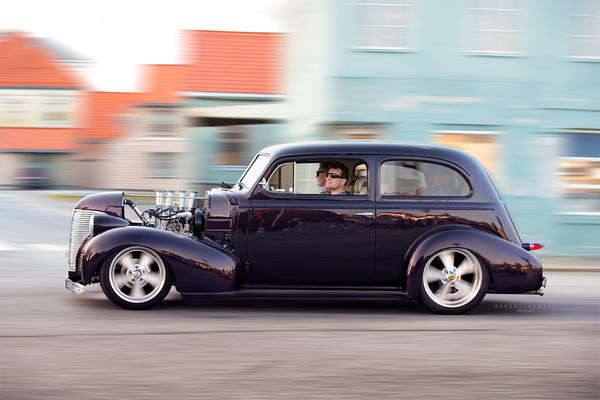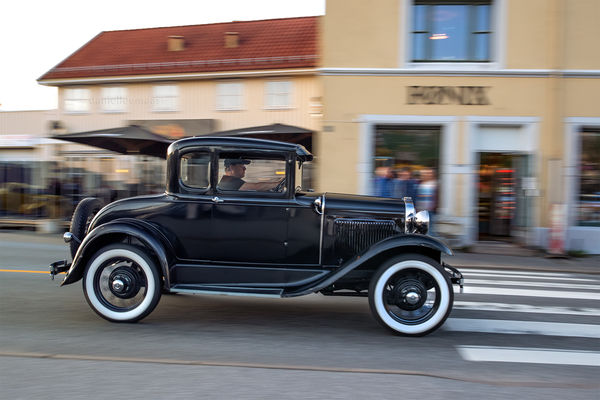fast motorcycles
Sep 11, 2019 17:16:58 #
larrylas
Loc: MA
Problem: would like to take two pictures of a motorcycle, One with background blurred the other with motorcycle blurred. SETTING day, cloudy and clear. Got ideas on starting ASA, Shutter speed and aperture?
Sep 11, 2019 17:25:15 #
The shutter speed is the main consideration, but that depends on the speed of the motorcycle and the distance you are away from the motorcycle, and how much blur you want. It's really a situation for a lot of experimentation and examination of results, and more experimentation. This is the kind of situation where being able to see the images immediately with digital is invaluable. And it's now ISO - ASA went away a long time ago.
Sep 12, 2019 07:58:48 #
As JohnSwanda noted, the distance factor plays a huge role, as a medium zoom from distance is going to have a blurred blob rather than a blurred motorcycle if the cycle is small in the frame. Any practice you do needs to replicate distance as well as settings and technique. Also, I can't remember the article/source but I recall an experienced shooter recommending that you experiment with your panning skills prior to the 'big shoot' to determine your personal 'longest' reliable panning shutter speed and then aim for that shutter speed on the 'big day'. The sharp bike, blurred background is, for me, the shot I'd rather have so I'd focus on that one, but as in all things artistic, it's preference. Good luck, and please share any results you like.
Sep 12, 2019 08:09:27 #
catchlight..
Loc: Wisconsin USA- Halden Norway
larrylas wrote:
Problem: would like to take two pictures of a motorcycle, One with background blurred the other with motorcycle blurred. SETTING day, cloudy and clear. Got ideas on starting ASA, Shutter speed and aperture?
Depends on the lens mostly, so speed of the subject will have little effect.
Typically the closer you are with ether wide or telephoto... the more motion blur will be happen... furthe away will reduce the effect.
Stationary blur on a tripod will be down to 30 sec no mater the lens.
70-200 IS lens would be 50-70th sec at 70mm. 200mm 90 to 125th sec.
50mm, 30th sec. Both cases you have to be steady and smooth horizontally and pace exactly on the subject with servo focus.
Those base settings will get you good wheel spin also...
Use Shutter priority. If the sun is going down rapidly go to auto iso.
Sep 12, 2019 08:46:12 #
larrylas
Loc: MA
catchlight.. wrote:
Depends on the lens mostly, so speed of the subjec... (show quote)
First thanks for ideas The shots are staged speed about 40 MPH I will be about 100' with a tripod and free hand. I use a Nikon D3400 I use both a 50 mm and a 300 mm lens (by the way I'm old school so terms I use terms that reflect that, but I do understand something have changed, but film speed, aperture as well as shutter speed are still what we work with) I'm 76 and I think I use to know at least the range to be in, not any more. I'm practing panning using cars (not as good as I once was)
Thanks and if you have other ideas please share
Sep 12, 2019 10:25:56 #
It’s ok with me to use ASA. I am 71 and using film again. But still need digital for sports etc.
Sep 12, 2019 11:37:59 #
catchlight..
Loc: Wisconsin USA- Halden Norway
larrylas wrote:
First thanks for ideas The shots are staged speed ... (show quote)
50 is best at about 20 to 30 feet from the cars. 300 is a bit long but will work if you have room. for an average track 200mm is better for me.
Use shutter priority and set up at 200th of a second and work down. Eventually you will dip below 100th sec with a 200mm.
Same with the 300 but you have to be steady and smooth. The trick is to track as smooth as you can as if you were dear hunting. You need an IS lens and then just experiment.
If you loose light then use auto iso. You can also adjust iso manually as conditions change.
Wheel spin will begin at 200th sec and everything gets amplified as you learn to be smooth and slow down the shutter speed.
Sep 12, 2019 15:53:51 #
amfoto1
Loc: San Jose, Calif. USA
larrylas wrote:
Problem: would like to take two pictures of a motorcycle, One with background blurred the other with motorcycle blurred. SETTING day, cloudy and clear. Got ideas on starting ASA, Shutter speed and aperture?
It depends upon a number of things....
1. How close are you to the action and how long focal length lens are you using?
2. How fast is the subject moving? What direction is the subject moving?
3. Can you use a tripod or at least a monopod?
4. If lens or camera has image stabilization, does it have a panning mode?
You can use a "dragging the shutter" technique with panning motion to photograph the moving motorcycle and cause the background to blur. How slow shutter speed you need to use will depend upon how close you are and how long focal length you're using. You will also find that parts of the subject will be blurred and that a percentage of your shots will turn out as expected, so take lots and lots of extra shots. The slower your shutter speed, very likely the fewer "keepers" you'll get. It's sort of a balancing act trying to find the shutter speed that renders the blur you want, but still captures the subject sharp enough.
You will get different results depending upon the direction the subject is moving. If it's coming directly toward you or directly away from you, you'll see less blurring than if it's moving past you perpendicularly and you are tracking it with a panning movement. If you put camera and lens on a tripod that has a smooth panning movement, you might increase the number of sharp shots. A monopod can work similarly.
Many of the lenses I use have image stabilization. Of those, many have a "panning mode", where the IS only works to counteract movement on the vertical axis. This is so that it's not "working against you" on the horizontal axis. In all honesty, I often forget to switch to panning mode and don't really see a lot of difference when shooting faster moving subjects.
Finally, fill flash can be used to freeze subjects more fully. However, it has to be set to "rear curtain sync" for the movement to appear "correct" behind the subject. If used with normal first curtain sync, the blur effects will be in front of the subject, making it appear to be going backwards.
Below are some examples. All these were done with APS-C crop cameras. Take that into account with respect to the lens focal lengths, in particular:
1. 1/60 shutter speed, 70-200mm lens at 85mm, f/16 aperture. I was quite close to the action and, if I had to guess, the car isn't going much faster than 40 or 50 mph on the straights, a lot slower in the corners. In this first shot, note how parts of the car are blurred, although the driver is sharp...

2. 1/60, 70-200mm lens at 200mm, f/16 aperture. The car is going slower in a corner AND is not moving perpendicular to me, so there's less blurring of the background or foreground objects in this image...

3. 1/800, 300mm lens, f/5.6 aperture. Compare the image below shot at a much faster shutter speed. Notice how all of the car movement is "frozen". Foreground and background blur here is due to depth of field with the longer focal length and larger aperture, instead of being movement blur...

4. For the panned image below I used an even slower 1/40 shutter speed, the same 70-200mm lens as above (at 200mm), f/16 aperture. Notice how both foreground and background are showing motion blur. Incidentally, this was a very fast, highly customized old Triumph Spitfire in all theses shots. If I remember correctly, he won his class and probably top honors for the day...

5. Now at a different event... the vintage races at Laguna Seca Raceway... it was impossible to do panned shots because I had to shoot through a small opening in protective fences. Subjects were going MUCH faster than the above autocross images... probably 70 or 80 mph through the corners and well over 100 mph on the straights. 1/1600 shutter speed, 300mm lens, f/5.6...

6. Here's a panning shot of a considerably slower subject where I used fill flash with rear curtain sync to better freeze the subject movement. 1/30, 24-70mm lens at 52mm, f/7.1 aperture. Note the background blur and how the horse's legs, which are moving more rapidly, are more strongly blurred...

7. Here's an experimental equestrian example done without fill flash, subject moving perpendicular to me, with even slower shutter speed and longer focal length: 1/25, 300mm at f/5.6...

8. Yet another shot with the same lens, settings and without flash... but this time with the subject coming more directly toward me, so is a little better defined...

9. For comparison, here's the same subject, lens etc. as above... except this time I froze all the movement with a 1/500 shutter speed (pls ignore the blown-out background. This is a lower resolution proof quality image. I fix backgrounds in my more finished images)...

10. Finally, here's a motion blur shot done much closer and with a much shorter focal length, much smaller subject running toward me... but still strongly motion-blurred by an extra slow shutter speed. 1/8, 12mm focal length, f/5.6...

Regarding the images where you want to make a sharp background (and foreground?), but allow the motorcycle to blur, will need to be done the same way... with a slow shutter speed. Except this time you should NOT pan the camera and follow the subject. Instead, keep it still and snap the shot as the bike passes through the image area. Depending upon how fast the motorcycle is moving, it may be really difficult to time the shutter release perfectly! I don't think I have any examples because it's not something I'd normally try to do.
Sep 12, 2019 17:45:27 #
larrylas
Loc: MA
Tex-s wrote:
As JohnSwanda noted, the distance factor plays a h... (show quote)
I think I agree clear bike blurred background might be best (also hardest) but working on one idea is easier. I might put up a picture of setting I'm using except it would be a stupid looking picture
Sep 12, 2019 17:48:08 #
Sep 12, 2019 17:53:15 #
larrylas
Loc: MA
use to use Speed Graphic on a good shoot I could do about 10 images a day, think there were at least a dozen steps one missed one junk used polaroid to see what I MIGHT have shot with 4X5
Sep 12, 2019 17:56:01 #
Sep 12, 2019 18:02:14 #
Sep 12, 2019 19:40:54 #
larrylas wrote:
Problem: would like to take two pictures of a motorcycle, One with background blurred the other with motorcycle blurred. SETTING day, cloudy and clear. Got ideas on starting ASA, Shutter speed and aperture?
There is no easy answer to this, other than try to perfect one goal - ie, panning where you have the bike in focus and not blurred, and the background is very blurred - first. This is harder to do. The other will be easier, since the camera will be still and all you have to do is either prefocus and without looking through the viewfinder, just snap the picture when the bike comes into the place where you prefocused.
Trial and error for shutter speed, shoot manual exposure and auto ISO at first. Then you can shoot manual ISO as well.
There are just too many variables to recommend any specific camera and lens settings. Oh, and turn off stabilization.
Good luck and post results.
Sep 12, 2019 20:16:12 #
catchlight..
Loc: Wisconsin USA- Halden Norway
Here are a variety
there is no magic and you don't have to be a scientist. Anything below 200th sec will get results with long lenses, and short lenses will require 30th- 40th of a second. The only thing you really need to be is steady and start shooting.
Reduce the shutter speed until your subject starts to blur. If you nail it the vehicle will be nice and sharp with good wheel spin and background blur.
An IS lens to get the best shots but not nessesary. I get a lot with my Fuji X100f and if im at a track it's usually a Canon 1dx MkII and a 200mm f/2.0 L IS or the 70-200 f 2.8 L IS.
there is no magic and you don't have to be a scientist. Anything below 200th sec will get results with long lenses, and short lenses will require 30th- 40th of a second. The only thing you really need to be is steady and start shooting.
Reduce the shutter speed until your subject starts to blur. If you nail it the vehicle will be nice and sharp with good wheel spin and background blur.
An IS lens to get the best shots but not nessesary. I get a lot with my Fuji X100f and if im at a track it's usually a Canon 1dx MkII and a 200mm f/2.0 L IS or the 70-200 f 2.8 L IS.
If you want to reply, then register here. Registration is free and your account is created instantly, so you can post right away.





